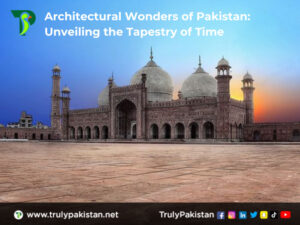Exploring the Grandeur: An Introduction to Pakistan’s Architectural Marvels
Badshahi Mosque: An Exemplar of Mughal Grandeur:
Our expedition commences at the Badshahi Mosque in Lahore, a magnificent testament to the Mughal era. Commissioned by Emperor Aurangzeb, this monumental edifice transcends the boundaries of being a mere place of worship. It stands as an architectural opus, meticulously crafted from red sandstone and white marble, showcasing the grandeur of Mughal craftsmanship. The intricate calligraphy and delicate carvings transport visitors to a time when artisans breathed life into stone.
Lahore Fort:
A Chronicle of Empires Adjacent to the Badshahi Mosque stands the Lahore Fort, a historical behemoth bearing witness to the ebb and flow of empires. With roots tracing back to the 11th century, the fort is a living testament to the architectural evolution spanning the Mughal, Sikh, and British periods. Walk through the Sheesh Mahal and the Shalimar Gardens to witness the architectural heritage etched in each brick.
Shalimar Gardens:
Serenity in Symmetry A short stroll from the Lahore Fort leads to the Shalimar Gardens, a Mughal masterpiece that speaks to the artistry of landscape architecture. Emperor Shah Jahan’s vision comes to life in terraced levels, reflecting pools, and meticulously crafted greenery. The Shalimar Gardens stand not just as a testament to architectural brilliance but as a sanctuary of serenity.
Mohenjo-Daro: Cradle of Civilization Venturing further back in time, we arrive at Mohenjo-Daro, a silent witness to the cradle of the ancient Indus Valley Civilization. The city’s meticulously planned streets, advanced drainage systems, and sophisticated architecture offer a glimpse into a civilization that flourished over four millennia ago. Mohenjo-Daro, with its ghostly ruins, whispers tales of an era long lost to the winds of time.
A Contemporary Twist: Modern Icons in the Landscape
Faisal Mosque, Islamabad: A Modern Icon Our journey shifts to the heart of Pakistan’s modern capital, Islamabad, where the Faisal Mosque emerges as a symbol of contemporary Islamic architecture. Completed in 1986, the mosque’s angular design departs from traditional domes and arches. The Faisal Mosque stands as a beacon, blending tradition with innovation and reflecting the dynamic identity of modern Pakistan.


Rohtas Fort: A Bastion of Strength Heading northward, we encounter Rohtas Fort, a formidable military fortress constructed by Sher Shah Suri in the 16th century. Nestled in the scenic Potohar Plateau, the fort’s massive walls and watchtowers reflect the military prowess of a bygone era. Rohtas Fort, with its strategic design, stands as a testament to the turbulence of the region’s history.
Hiran Minar, Sheikhupura: An Emperor’s Tribute Not far from Lahore, Hiran Minar (Deer Tower) invites us into a realm of poetic architecture. Built by Emperor Jahangir in memory of his pet deer, the structure, set against a sprawling pond, features a minaret adorned with stone antlers. Hiran Minar captures the Mughal emperors’ penchant for harmonizing nature and architecture, creating a tranquil and picturesque setting.
Glimpses of Gandhara: Traversing Ancient Trails
Taxila: Whispers of Gandhara
Venturing into the heart of the Gandhara region, our odyssey leads us to the ancient archaeological marvel of Taxila. Designated as a UNESCO World Heritage site, this hallowed enclave safeguards the vestiges of a civilization that reached its zenith over two millennia ago. Nestled within its sacred boundaries are Buddhist monasteries, stupas, and meticulously crafted statues, serving as poignant testaments to the profound artistic and cultural dialogues that transpired between the realms of Gandhara and Hellenistic influences. Taxila reflects the cultural diversity that has woven itself into the fabric of Pakistan’s identity.
Wazir Khan Mosque, Lahore: A Symphony of Tiles
Returning to Lahore, we encounter the resplendent Wazir Khan Mosque, renowned for its vibrant tile work and masterful artistry. Erected in the 17th century, the mosque’s interior is bedecked with intricate floral motifs, calligraphic elegance, and geometric precision. The vivid palette of blue, green, and yellow tiles assembles an enchanting visual mosaic, firmly establishing the Wazir Khan Mosque among Pakistan’s most visually captivating edifices.
Honoring the Founder’s Legacy: A Tribute to Leadership
Quaid’s Mausoleum, Karachi: A Nation’s Reverence
Our voyage culminates at the Quaid’s Mausoleum in Karachi, the ultimate resting place of Muhammad Ali Jinnah, the visionary founder of Pakistan. This monumental edifice, characterized by its pristine white marble elegance, serves as an enduring tribute to Jinnah’s exceptional leadership and foresight. The mausoleum transcends being a mere stone structure; it is a sacred sanctuary, paying homage to a leader whose indelible influence profoundly shaped the course of a nation’s destiny.
Conclusion: The Living Legacy of Pakistan’s Architectural Wonders
In conclusion, the architectural wonders of Pakistan are more than just physical structures; they are living testaments to the spirit of a nation that cherishes its history while embracing the future. From the ancient urban planning of Mohenjo-Daro to the modernity of the Faisal Mosque, each structure reflects the resilience, diversity, and cultural mosaic that define Pakistan today. As visitors traverse these sites, they not only witness the magnificence of the past but gain insights into a nation’s journey through the corridors of time. The architectural wonders of Pakistan stand tall, beckoning explorers to unravel the stories etched in stone and celebrate the living legacy of a nation shaped by its architectural heritage.


One thought on “Architectural Wonders of Pakistan: Unveiling the Tapestry of Time”